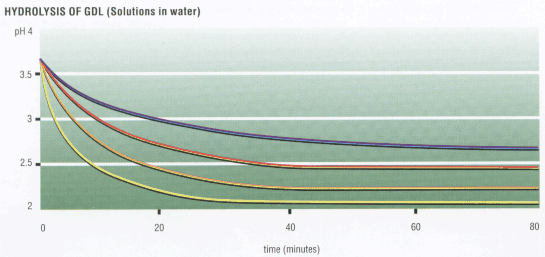
Typical pH variation with time of Gluconal® GDL solutions in water, depending on concentration (1% and 5% w/w) and temperature (20 and 40oC).


![]()
![]()
| The manufacturing of meat products like raw sausages, frankfurter-type cooked sausages and variations of them, is one of the most complicated processes in food production today. The slightest deviation of the raw materials or the conditions applied results in a quality variation of final product. | |
| The ripening process as well as the curing and red color formation process of sausages are highly dependent upon the pH of the medium in which they take place. Under the influence of a lower pH, these processes unwind faster and are more complete in the end. The ripening time greatly increases the costs of manufacturing the product. This is why about 30 years ago the souring agent GDL was introduced to accelerate the relatively slow bacteriological acidification. | |
| In
meat product GDL becomes hydrolysed to gluconic acid under the influence
of meat's own water content, gradually decreasing the pH of the system in
a controlled manner. GDL reaches its lowest pH after approx. 40 to 60 minutes
or more, depending on the substrate, the concentration of GDL and the temperature
applied. The speed of hydrolysis and thus the speed of acidification can
be accelerated by increasing temperature. Following figure shows the typical pH variation with time at various concentrations of GDL, determined in water. |
|
| Cooked sausages are mainly known as "frankfurters", but there exists various types and variations of these frankfurter-type meat sausages like knackwurst, wiener, thuringer, special types of salami and mortadella, mettwurst, teawurst etc. Additionally, there are many regional variations, however all of these frankfurter-type sausages are made from fresh meats, cured during processing, fully cooked and smoked. | |
|
Cooked sausages consist mainly of raw meat, fat and water and various additives like salts, phosphates, glycerides, proteins, food acidulants, spices and flavors. These additives have to assure a safe and successful manufacturing process, a high-quality finished product, stability and cut resistancy of the protein-fat-water emulsion even when scalded or cooked several times. |
|
| Most
cooked sausages belong to the category of cured sausages, which means that
they have been cured for good red color development with nitrites. All reactions
underlying the curing and red color formation processes are highly dependent
upon the pH of the medium in which they take place. Under the influence
of a lower pH, these processes unwind faster and are more complete at the
end. Common frankfurter-type sausage preparations have a pH of 5.8 or slightly above. The addition of agents promoting acidity has become a frequently adopted practice. The preferred choice for such functional ingredients is GDL since it allows a well-controlled slow drop of the pH value. GDL can be added together with all other additives directly to the grinded meat mass, before the sausages are filled into casings, cooked and smoked. An addition of 0.1 to 0.2% GDL (max. 0.3%, otherwise the final product becomes too sour) should be sufficient in order to reach the desired pH value. |
|
| When GDL is used in frankfurters along with reducing compounds such as sodium erythorbate, GDL promotes faster development of color during smoking. Smoking house time can be reduced by as 50%, and the finished frankfurters are said to exhibit less shrinkage and longer shelf life. | |
|
The
use of GDL
|
|
![]()
